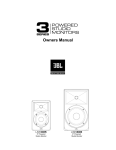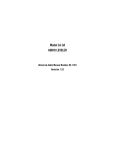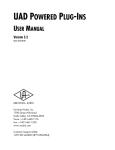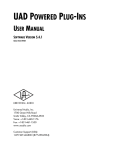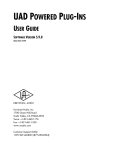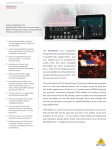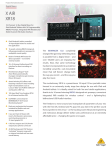Download Universal Audio 2108 Operating instructions
Transcript
Model 2108 Microphone Preamplifier Universal Audio Part Number 95-0009 Revision 1.20 Universal Audio, Inc. www.uaudio.com PO Box 3800 Santa Cruz, CA 95063-3818 (831) 466-3737 voice (831) 466-3775 fax www.uaudio.com The 2108 Microphone Preamplifier Thank you for purchasing the 2108 Dual Channel Microphone Preamplifier. The 2108 was inspired by the 1108 line amp developed by Universal Audio in the early sixties. The original 1108 was the “father of the 1176 limiter”. The classic sound of the legendary 1176 starts with the line amp / output transformer of the 1108. In fact, the 1176 was born as a result of my father’s (Bill Putnam Senior) desire to create a remote controlled pre amp. Most of us at Universal Audio are musicians, recording engineers, or both and we wanted to build a mic preamp that we’d be delighted to use ourselves. We love the recording process, and we really get inspired when the basic tracks are beautifully recorded. Our design goal for the 2108 was to capture the original character of the 1108 and to create a solid state mic pre reminiscent of that era. Like all of the great vintage gear of that time, the 2108 is an all discrete class A unit with input and output transformers. In addition to the output stage used in the 1176, the 2108 features our best custom input transformer (featuring multiple impedance windings) and a new FET front end with incredible sonic dynamics. The controls on the 2108 are simple and essential: we added only those features required for practical use without needless duplication of functionality found elsewhere in most studios. In addition to the basic controls for phantom power, polarity and levels, the 2108 features a unique Signal Indicator for each channel. The single translucent jewel glows brighter as signal strength is increased, changing from green to amber then red. The indicator light can monitor the Input Stage or the Output Stage of the 2108. Although more expensive than some, the 2108 defines a break through value for a tool in this class. It is with great pleasure that we bring another piece of “vintage soul” to the world of music makers. In addition to the 2108, Universal Audio manufactures the 1176LN Limiting Amplifier, the classic Teletronix LA-2A Leveling Amplifier, the 2-610 and M610 tube pre amps. We plan to offer additional original designs, vintage reproductions, and digital products that meet the demands of the modern recording studio, yet retain the character of vintage equipment. Please see our Web Site for more information. www.uaudio.com These products have been quite an enjoyable adventure to develop and we’re sure the next phase will be even more fun! We thank you for your support and we thank my father, Bill Putnam. Thank you, Bill Putnam ii IMPORTANT SAFETY INSTRUCTIONS Before using this unit, be sure to carefully read the applicable items of these operating instructions and safety suggestions. Afterwards keep them handy for future reference. Take special care to follow the warnings indicated on the unit itself. as well as in the operating instructions. Water and Moisture – Do not use the unit near any source of water or in excessively moist environments. Carts and Stands – The unit should be used only with a cart or stand that is recommended by the manufacturer. The unit and cart combination should be moved with care. Quick stops, excessive force and uneven surfaces may cause the unit and cart combination to overturn. Object and Liquid Entry – Care should be taken so that objects do not fall, and liquids are not spilled, into the enclosure through openings. Wall Or Ceiling Mount – The unit should be mounted to a wall or ceiling only as recommended by the manufacturer. Ventilation – When installing the unit in a rack or any other location, be sure there is adequate ventilation. Improper ventilation will cause overheating, and can damage the unit. Cleaning – The unit should be cleaned only as recommended by the manufacturer. Heat – The unit should be situated away from heat sources, or other equipment that produces heat. Nonuse Periods – The AC power supply cord of the unit should be unplugged from the AC outlet when left unused for a long period of time. Power Sources – The unit should be connected to a power supply only of the type described in the operating instructions, or as marked on the unit. Damage Requiring Service – The unit should be serviced by qualified service personnel when: Power Cord Protection – AC power supply cords should be routed so that they are not likely to be walked on or pinched by items placed upon or against them. Pay particular attention to cords at plugs, convenience receptacles, and the point where they exit from the unit. Never take hold of the plug or cord if your hand is wet. Always grasp the plug body when connecting or disconnecting it. Grounding of the Plug – This unit is equipped with a 3-wire grounding type plug, a plug having a third (grounding) pin. This plug will only fit into a grounding-type power outlet. This is a safety feature. If you are unable to insert the plug into the outlet, contact your electrician to replace your obsolete outlet. Do not defeat the purpose of the grounding-type plug. • The AC power supply cord or the plug has been damaged; • Objects have fallen or liquid has been spilled into the unit; • The unit has been exposed to rain; • The unit does not operate normally or exhibits a marked change in performance; • The unit has been dropped, or the enclosure damaged. Servicing – The user should not attempt to service the unit beyond that described in the operating instructions. All other servicing should be referred to qualified service personnel. iii Notice This manual provides general information, preparation for use, installation and operating instructions for the Universal Audio 2108 Microphone Preamplifier. The information contained in this manual is subject to change without notice. Universal Audio, Inc. makes no warranties of any kind with regard to this manual, including, but not limited to, the implied warranties of merchantability and fitness for a particular purpose. Universal Audio, Inc. shall not be liable for errors contained herein or direct, indirect, special, incidental, or consequential damages in connection with the furnishing, performance, or use of this material. Copyright © 2002 Universal Audio, Inc. All rights reserved. This manual and any associated software, artwork, product designs, and design concepts are subject to copyright protection. No part of this document may be reproduced, in any form, without prior written permission of Universal Audio, Inc. Trademarks LA-2A, 1176, 2-610, M610, 2108 and the Universal Audio, Inc. logo are trademarks of Universal Audio, Inc. Other company and product names mentioned herein are trademarks of their respective companies. iv Table of Contents The 2108 Microphone Preamplifier............................................................................... ii 2108 Specifications .................................................................................................... 1 Operating Instructions ................................................................................................. 2 Front Panel ...................................................................................................... 2 Gain ...................................................................................................... 2 Level ...................................................................................................... 3 Z-in Select (Input Impedance) .................................................................... 3 Polarity .................................................................................................. 3 +48 V (Phantom Power ............................................................................ 3 Ouput Input (Signal) ................................................................................ 4 On / Off (Power) .................................................................................... 4 Rear Panel ....................................................................................................... 4 Input/Output Connectors .......................................................................... 5 DC Power Input ....................................................................................... 5 DC-30 Power Supply ................................................................................................... 5 Voltage Selector Switch ..................................................................................... 6 AC Power ........................................................................................................ 6 Fuse/Mains ..................................................................................................... 6 History ...................................................................................................................... 7 v 2108 Specifications Microphone Input Impedance Selectable, 1 kΩ or 4 kΩ Hi-Z Input Impedance Selectable, 58 kΩ or 2 MΩ Maximum Microphone Input Level +8 dBu Maximum Output Level +26 dBm Recommended Minimum Load 600 Ω Frequency Response 20 Hz to 20 kHz ± .5dB Maximum Gain 65 dB Signal-to-Noise -165 dB EIN @ 65 dB Gain Power Requirements DC-30 Power Supply & 2108 DC Power Cable Dimensions 1U rack, 11.5” deep Weight 10.85 lbs. DC-30 Power Supply Specifications Power Requirements 115V/230V Dimensions 2.4” Height, 4.6” Width, 11” Length Weight 4.5 Lbs 1 Operating Instructions The 2108 is a two-channel, solid state microphone / instrument preamplifier. Each channel has two gain stages operating in a class A single-ended configuration. Variable negative feedback is applied to both of these stages to control gain and “color”. Balanced inputs and outputs are transformer coupled. 2108 Front Panel The front panel has two identical channels (Figure ) each with an eleven position detented Gain control that doubles as an input selector. In addition, each channel has Level, Polarity, 48V Phantom power, Signal Monitoring and Input Impedance (Z-in) controls as well as a Hi-Z Input jack. A multi color signal strength indicator is located between each channels push button array. The Power switch and associated “on” light is located on the far right. Each control is discussed in the following sections. Figure 1: 2108 front panel Gain The Gain switch determines which input is active and the “system gain” of the pre amp. The rear chassis XLR Mic Input is always selected, unless the Gain control is turned to one of the three Hi-Z settings marked on the front panel. In general, using higher settings (50 - 65) will produce more “colored” results. 2 Level The Level knob is the master volume control. It determines the amount of signal from the preamplifier gain stage sent to the output stage. The cleanest signal is attained by setting the Level knob between 7 and 10 on the scale, then turning the Gain knob until the desired level is attained. Altering the Gain, Z-in Switch, and Output controls together provides many useful tonal variations. The numeric values on the front panel for the Level control denote magnatude and are NOT specific dB values. When the Level control is set to 10, the total system gain will be the dB value selected by the Gain control. Z-in Select The Z-in push button switch provides two different input impedance choices for the Mic Input and two different impedance choices for the Hi-Z Input. The impedance for the MIC INPUT can be set to 1 KΩ or 4 KΩ. Pushing the Z-In Select button in will select 1 KΩ When the button is out, 4 KΩ is selected. Switching between these two positions while listening to a connected microphone may reveal a different tonal quality and/or gain. A typical mic preamplifier should have an input impedance equal to about 10 times the mic output impedance. For example, if your mic has an output impedance between 150 Ω and 200 Ω, set the switch to the in position. However, since making music is not necessarily about adhering to technical specifications, feel free to experiment with the settings to attain the desired sound. You will not harm your microphone or the 2108. The impedance for the Hi-Z INPUT can be set to 58 KΩ or 2 MΩ. Pushing this button in will select 58 KΩ.When the button is out, 2 MΩ is selected. The 58 KΩ setting is best suited for -10 dBv level signals, typically found on active basses and guitars. This setting is also appropriate for devices with unbalanced line outs, such as keyboards and drum machines. The 2 MΩ setting is appropriate for instruments with passive pickup systems. Since an instrument’s output impedance may be somewhere between the active and passive levels, feel free to experiment to achieve the best sound at the desired level. Rev ø The Rev ø push button reverses the polarity of the 2108 output when it is pushed in. When pushed in pin 3 is hot (positive). When the button is out pin 2 is hot (positive). +48 V (Phantom Power) The +48V push button applies phantom power to the Mic Input XLR jack on the rear chassis. Pushing this button in “turns on” the +48 volts. When the button is out, the +48 volts is off. Most modern condenser mics require phantom voltage to operate and we recommend checking the requirements of your microphones before connecting them. It is good practice to keep phantom power off when it is not required. To avoid loud transients, always keep the phantom power off when connecting or disconnecting microphones. 3 Output Input (Signal) The Signal Output Input push button selects which amp stage the Signal indicator is monitoring. When the button is pushed in, the light will indicate signal strength measured at the input of the final amp stage. When the button is out, the light will indicate signal strength at the output of the 2108. Button In. It is useful to push this button in and monitor the input while adjusting the Gain control. This can help determine how hard you want to drive the first stage. The SIGNAL indicator is a tri colored LED. It will be green when a low level signal is present, changing to amber, then red as signal strength is increased. Important Note! Red does not indicate clipping. When monitoring the Input (button in) red indicates the level at which gentle saturation begins. It is possible to drive the 2108 with a healthy amount of gain resulting in the signal light flashing red 50% of the time. This will produce a harmonically rich sound with a bit of edge. Trust your ears. Button Out. Pushing the button out provides monitoring of the signal that is adjusted by the Output control. This can help you stay on top of levels fed to your recorder or subsequent device. In this state, red indicates 12db which does not indicate clipping, but serves as a warning to check the level at the next device in line (recorder, mixer, A/D unit, etc.). On / Off (Power) This button switches the DC power from the DC-30 Power Supply. When the button is toggled up the 2108 will “pause” for about 4 seconds before audio can be heard. This mute period eliminates power up and power down noise. The 2108 must be connected to the DC-30 Power Supply with the supplied 7 pin XLR cable and the DC-30 AC switch must be on. In normal use the 2108 On / Off button can serve as a “standby” or “signal mute” switch. Please read the DC-30 Power Supply section starting on page 5 of this manual. 2108 Rear Panel The rear panel (Figure ) has two identical channels each with MIC INPUT and LINE OUTPUT XLR connectors. Also, the rear panel has a DC POWER INPUT receptacle. These connectors are discussed in the following sections. Figure 2: 2108 rear panel 4 Input/Output Connectors Standard XLR input and output connectors are provided on the rear panel. Pin 2 is wired positive (hot) on the MIC INPUTS. Pin 2 is positive on the LINE OUTPUT when the front panel Polarity switch (Rev ø) is in the normal out position. Pin 3 is positive on the LINE OUTPUT when the front panel Polarity switch is pushed in (selecting the reverse phase condition). DC Power Input Connect the 2108 to the DC-30 Power Supply box using the supplied 2108 DC Power Cable. Be sure the DC-30 Power Supply is turned off before connecting the 2108 DC Power Cable to the 2108. Important! Never plug any other device into the 2108 DC Power receptacle on the rear chassis of the 2108! DC-30 Power Supply The 2108 ships with an external power supply which provides DC voltages to the 2108 via a supplied 7 pin XLR cable. Always use the supplied DC Power Cable. Using a similar looking cable may damage the 2108 and the DC-30 Power Supply. The DC-30 has an illuminated AC power switch. When this switch is on, the power supply will provide the 2108 with DC power. Both the 2108 power switch and the DC-30 power switch must be on for the 2108 to work. Figure 3: DC-30 front rear & panels 5 Voltage Selector The 2108 can operate at 120 V or 240 V. To change the mode, unplug the AC power cord from the DC-30 Power Supply. Remove the top cover. Looking down on the unit, locate the round Power Transformer at the front of the unit. Unplug the transformer connector with the larger wires and reconnect it to the appropriate headed as shown in Figure 4. This figure shows the unit configured for 240 volt operation. When changing the operating voltage the fuse must be changed as well (see fuse/mains below). It is very important to only move the connector that is plugged in to the header that is marked 120V or 240V. Do not move the connector shown to the left on the photo below. Make sure the DC30 Power Supply is properly set for the voltage in your area before applying AC power to unit! Figure 4: Operating Voltage Selector AC Power The DC-30 uses a standard, detachable IEC power cable. Fuse/Mains The AC power fuse is located in the AC power connector block. Remove the power cord before checking or changing the fuse. A 400 mA time delay (slow blow) fuse is required for operation at 120 V. A 200 mA time delay (slow blow) fuse is required for operation at 240 V. 6 History Bill Putnam Sr. was awarded the 2000 Technical Achievement Grammy for his multiple contributions to the recording industry including the design of the modular console. Highly regarded as a recording engineer, studio designer, and inventor, Putnam was a favorite of Frank Sinatra, Nat King Cole, Ray Charles, Duke Ellington, Ella Fitzgerald and many other musical icons. The studios he designed and operated were acclaimed for their distinctive sound and provided a fertile environment for his innovations and experiments. Universal Recorders in Chicago, United and Western in Los Angeles (now Ocean Way and Cello) all preserve elements of his room designs. Putnam started three companies (Universal Audio, Studio Electronics, and UREI) that built products which remain widely used decades after their introduction. In 1999 Putnam’s sons, Bill and James, re-launched Universal Audio with two goals: • reproduce classic analog recording equipment designed by their father and his colleagues; • research and design new recording tools in the spirit of vintage analog technology. Beginning in 1999, Universal Audio has rapidly released two reproductions of classic compressors (1176LN and Teletronix LA-2A), designed a new mic-preamp (2-610), acquired Kind of Loud Technologies, and launched its first digital product line (Powered Plug-Ins). Each and every UA project is motivated by it historical roots and a desire to wed classic analog sound with modern recording technology. This year (2002) we are proud to introduce the 2108 Dual Channel Microphone & Instrument Preamplifier to our growing family of products. The 2108 is a unique blend of attributes. The sonic character comes from the timeless vintage circuits borrowed from the 1176 limiter, the 1108 pre-amp modules and the 2-610 Input transformer. This winning combination is enhanced by a dynamic JFET input stage that allows for fine control of an extremely smooth and gentle saturation feature. In the studio we have found the 2108 to provide most pleasing results for all applications. In particular, stunning presence and punch is derived from typically mellow ribbon mics and common dynamic mics. Of course, condensers and tube mics as well also shine and benefit form the flexibility of the multi impedance / variable gain input section. The 2108 character provides excellent results on drums, vocals, acoustic piano, guitars, speaker cabinets, percussion, etc. In addition, the front panel Hi-Z Instrument Input delivers extremely rewarding results for direct recording of electric guitar and bass. We sincerely hope you will find this product as exciting as we do! It is with great pleasure that we strive to merge the best of the Universal Audio heritage with new “classic” products. We hope to hear from you and learn about your recording (and live sound) experiences. Sincerely, the Universal Audio staff. Enjoy! 7













